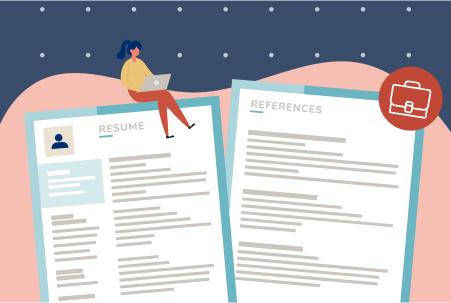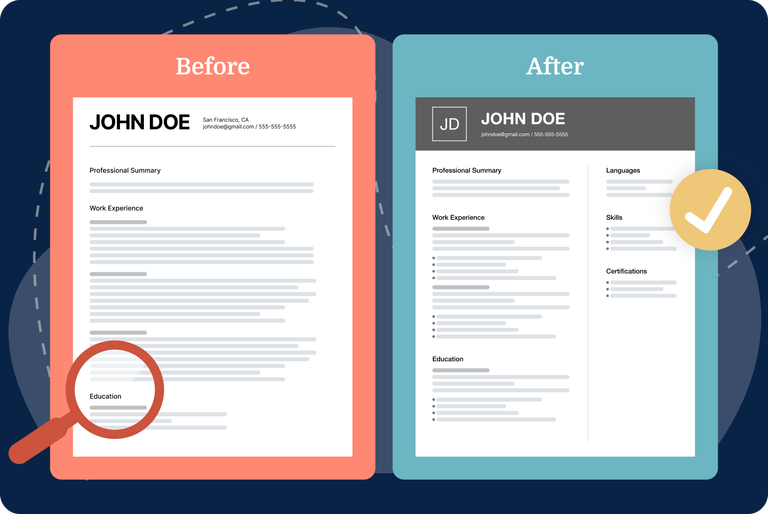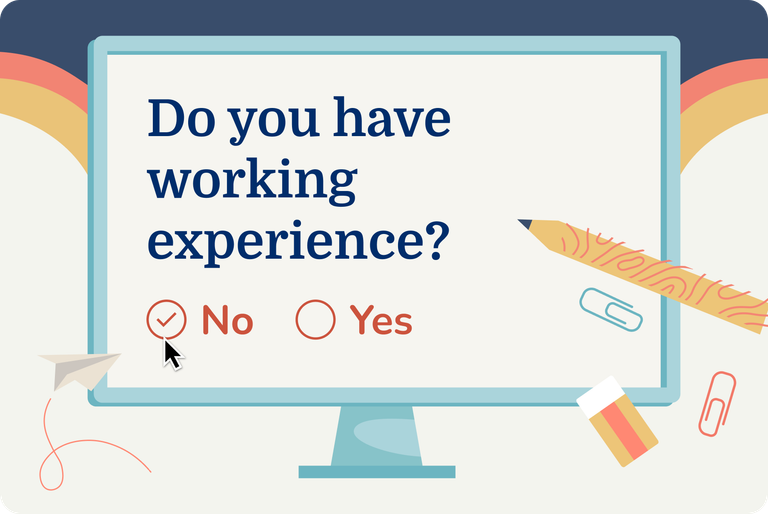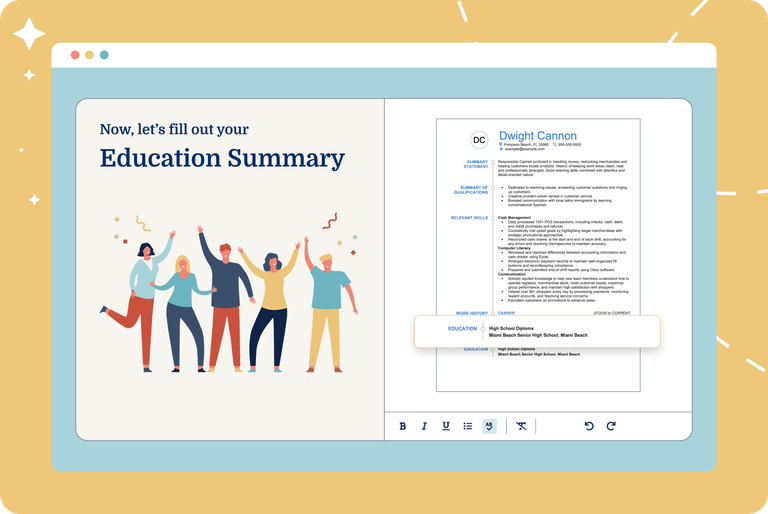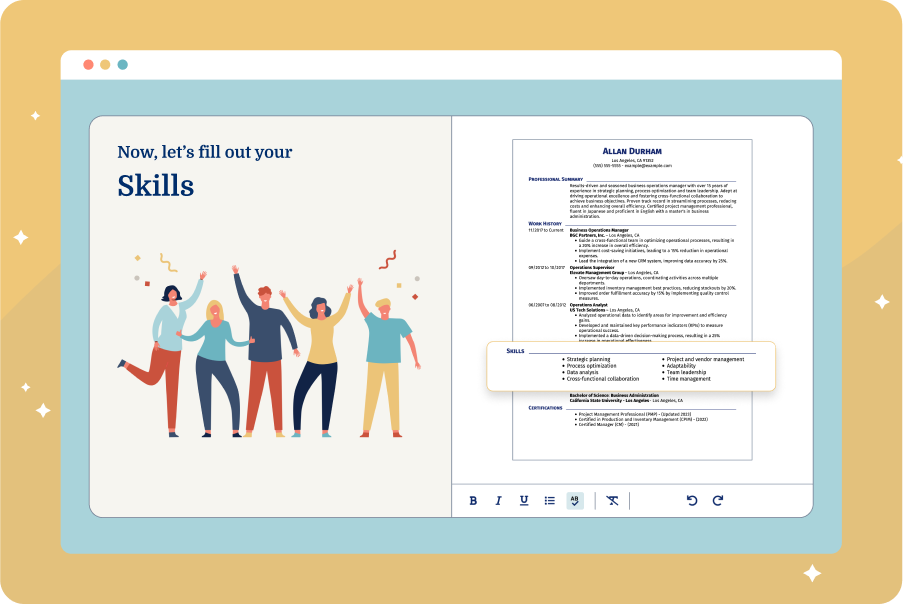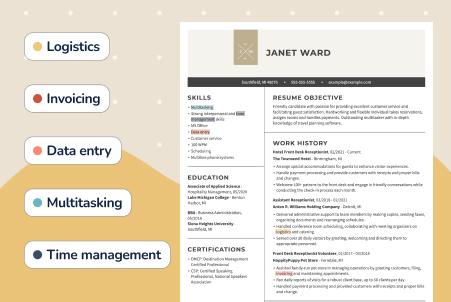Our customers have been hired at: *Foot Note
If you're working on your resume, you might be wondering whether to include references. The short answer? Avoid listing references directly on your resume.
Most employers don’t expect to see references upfront, and doing so can distract from more important details about your skills and experience.
In this guide, we’ll explain why references don’t belong on your resume, when to share them, and how to create a polished reference page that’s ready when you need it.
Should You Put References on a Resume?
You should not list references directly on your resume. Employers typically request references after an initial interview or when you're a top contender for the role.
When writing your resume, focus on your qualifications, experience, and achievements. Space is limited, and every line should help sell your skills.
References (or the phrase “References available upon request”) don’t add value and can be better replaced with content that shows why you are a great fit for the role.
Modern resumes should look streamlined and professional. Adding references can clutter the layout and give the impression that you’re not up to date with current resume standards.
Instead of adding references to your resume, create a separate reference page you can share when it’s requested. This keeps your resume clean and shows you understand current hiring practices.
What Is a Resume Reference Page?
A resume reference page is a document that lists the names and contact information of former managers, colleagues, or mentors who can vouch for your qualifications and work ethic.
Unlike your resume, the reference page isn’t submitted with every job application. Instead, it’s prepared ahead of time and shared only when an employer specifically asks for it.
Here’s an example of how to structure a reference page for a resume:
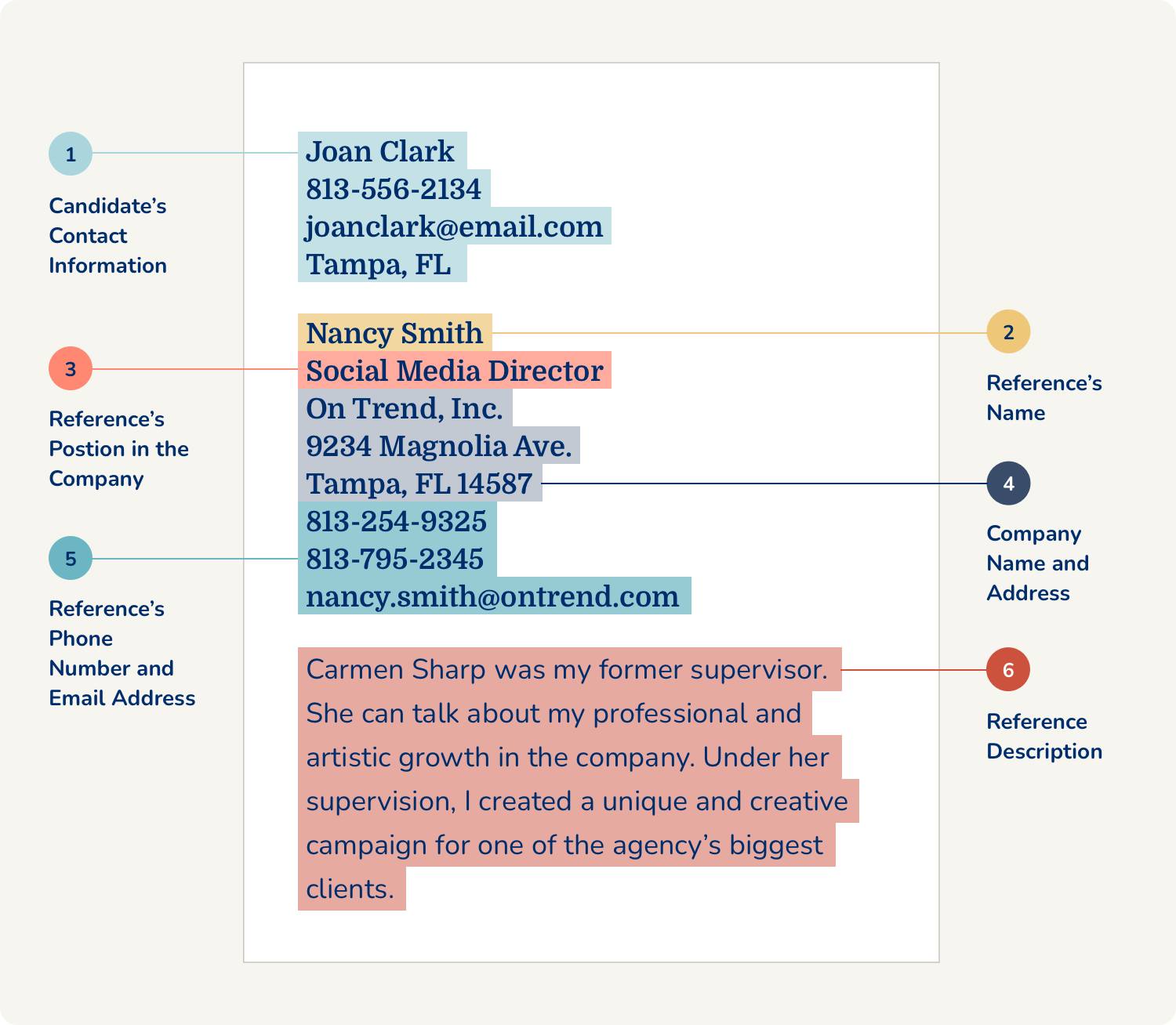
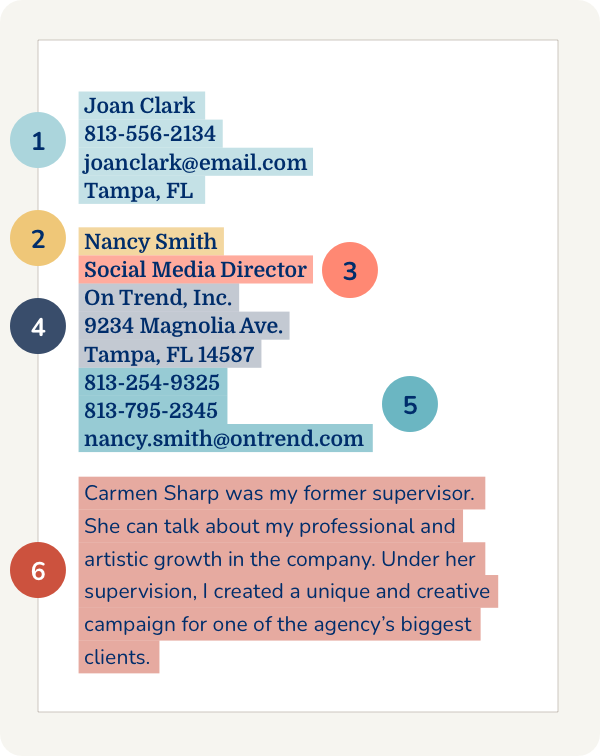
When Should You Submit References for a Job?
References are typically requested when you’re being seriously considered for a role, often as one of the final steps before a job offer is made.
You should only submit a reference page when an employer specifically requests one, typically during or after the interview process.
Here are common situations when you might be asked to provide a reference page:
- When the job posting specifically asks for references to be submitted along with your resume and cover letter
- When you're completing a job application that includes a separate section or field requesting references directly
- After you’ve completed a successful interview and the employer wants to verify your background or learn more about your work style
- When you're in the final stages of hiring, such as during a background check or just before a formal job offer is made
How To Make a Reference Page for a Resume
A well-organized reference page shows you're prepared and professional when an employer requests one. Explore the steps below to learn how to write a reference page for a resume.
1. Select three to five references (or the number requested)
When building your reference page, be selective about who you include. Aim for individuals who can speak positively about your professional skills, work ethic, and character.
In most cases, you should include three to five references on your reference page. If the job description specifies a certain number of references, make sure to match that exactly.
Choose a mix of people who can speak to different aspects of your experience and confidently recommend you for the role you're applying for. Ideally, choose from the following:
- Former managers or supervisors
- Colleagues you've worked closely with
- Mentors or instructors (if you're early in your career)
- Clients or business partners (if applicable)
If you're just starting out or writing a career change resume, you can include references from academic or volunteer roles.
2. Ask before listing someone as a reference
You should contact your references and ask for their permission before including them on the reference page for your resume. Here is an example of how to begin this conversation:
Having this conversation, either in person, by phone call, or by email, is a common courtesy and allows your references to prepare to discuss your skills if the hiring manager reaches out to them.
When you reach out, let them know what kind of role you’re applying for, why you think they’d be a good reference, and request their preferred contact information.
Consider sharing a copy of your resume or reminding them of specific projects you worked on together. This helps them give a more personalized and supportive recommendation.
3. Match the style of your resume
Use the same heading structure as your resume header to keep your application materials consistent and polished.
This means your name and contact information should appear at the top of your reference page, formatted the same way they appear on your resume.
Creating a document with the same look and feel as your resume template reinforces your professionalism and makes it easier for hiring managers to keep track of your materials.
4. List each reference with complete details
Organize your references in a simple, professional layout. Use consistent spacing, fonts, and formatting to ensure it’s easy to scan. For each reference, include the following information:
- Their first and last name
- Their professional title
- The name of their workplace
- The company’s address, including city, state, and ZIP code
- Their business phone number
- Their email address
- Brief reference description explaining your working relationship
Remember to keep their information strictly professional. Don’t include personal information, a phone number, or email address they didn’t permit you to use, or their home address.
5. Download your resume reference page
Since you’ll likely be submitting your reference page digitally, save it in a universal file format like PDF to ensure the formatting stays intact across different devices.
Keep a copy of your reference page easily accessible so you can respond quickly and professionally whenever a hiring manager requests it.
While you craft your job applications, we recommend using our Resume Builder to simplify the resume creation process with professional templates and content suggestions.
Resume Reference Page Examples
Use these examples as inspiration to create your list of references. If you’d like to have one cohesive job application, we recommend exploring our resume examples and templates.
Example with three references
Carmen Sharp
Creative Director
POV Agency
3987 Cherry Camp Road
Junction City, CA 96048
773-477-2686
909-227-4436
carmen.sharp@pov.com
Carmen Sharp was my former supervisor. She can discuss my professional and artistic growth in the company. Under her supervision, I created a unique and creative campaign for one of the agency’s biggest clients.
Darlene R. Callahan
Graphic Designer
POV Agency
3987 Cherry Camp Road
Junction City, CA 96048
909-142-0788
darlene.call@pov.com
I worked with Darlene on multiple projects and commercial campaigns. She can talk about my work ethic, creative thinking, and time management skills.
Julian McFadden
Art Director
We Create, Inc.
8765 Thomas Road
Junction City, CA 96048
773-903-6512
909-887-2235
julian.mcfadden@wecreate.com
Julian McFadden pushed me to become a better designer, and I learned new Photoshop skills with his guidance. He can vouch for my ability to learn quickly and not buckle under pressure.
Example with five references
Paul D. Grimes
Director of Sales
LMT Company
2877 Grey Road
Williamsport, PA 17701
570-327-9954
570-279-0654
paulgrimes@lmt.com
Paul Grimes witnessed my negotiation and marketing skills getting better with time. I helped him during meetings with clients and eventually started negotiating independently.
Ruby Moreno
Regional Sales Manager
LMT Company
2877 Grey Road
Williamsport, PA 17701
570-223-0756
rubymore@lmt.com
Ruby can testify to my great organizational skills and work ethic. With her guidance, I helped the team exceed sales goals in the north region.
Sean Brandt
Professor, Patterson School of Business
Pennsylvania State University
7898 Oak Avenue
Williamsport, PA 17701
570-477-1580
seanbrandt@pennuni.com
During my MBA, Sean Brandt was my professor on various courses and thesis supervisor. He can testify to my hard work and ability to adapt and learn quickly.
Lena Matthews
Marketing Manager
BrightWave Solutions
1124 Harbor Drive
San Diego, CA 92101
619-555-2043
lena.matthews@brightwave.com
Lena was my direct supervisor during my time as a marketing assistant from 2021 to 2023. She can speak to my creativity, teamwork, and ability to manage projects under tight deadlines.
Carlos Nguyen
Operations Director
Greenfield Logistics
4562 Central Blvd
Columbus, OH 43215
614-883-3901
carlos.nguyen@greenfieldlogistics.com
I worked under Carlos for two years as a supply chain coordinator. He’s familiar with my attention to detail, problem-solving skills, and ability to lead cross-functional teams on complex projects.
Tips on Choosing Professional References
You know how to create a list of references, so let’s now talk about whom to list as references. There’s more to it than just selecting someone you know and have worked with.
Focus on quality professional references
Be selective of the references you choose to send to a potential employer. Remember, these are people the recruiter or hiring manager will be asking directly about you.
When considering references for a resume, they should:
- Be familiar with your abilities and achievements
- Enthusiastically advocate for you
- Be able to think on their feet and answer questions without missing a beat
- Be trustworthy enough not to jeopardize your application
See how to follow up on a job application to increase your chances of getting noticed and moving forward in the hiring process.
Choose references based on your career level
Your list of references should be varied and include people in other positions and departments—don’t just include your manager or supervisor.
If you’re a mid-level candidate, your references list should include:
- Someone in a higher position
- Someone at your career level
- Someone from another department
For example, if you’re a copywriter, you could ask your creative director, the graphic designer you worked with, and the account manager you interacted with to be your references.
If you’re a manager, your professional references should be:
- Someone in a position higher than yours
- Someone at your same career level
- A team member in a position below yours
Each of them will talk about what it’s like having you as a manager. So, for example, you could select your supervisor, another manager, and employees from the department you managed.
Search for references outside your current job
A professional reference doesn't always have to come from your current or most recent role.
It’s often appropriate to list former colleagues, supervisors, mentors, or even clients and vendors you collaborated with regularly.
Think about the responsibilities of the job you’re applying for and choose references who can speak directly to the skills and qualities that align with that role.
Tailoring your reference list this way helps reinforce your fit for the position, even if those individuals aren’t from your current workplace.
Remember to also tailor your resume for the role by including skills, experience, and qualifications that align with the job description.
Key Takeaways
- Don’t include references on your resume. Save space for your skills, experience, and achievements—references should be listed on a separate document.
- Create a clean, professional reference page. Match the style of your resume and include full contact details along with a brief description of your relationship to each reference.
- Only submit your reference page when asked. This typically happens after an interview or in the final stages of the hiring process.
- Choose references who can speak to your strengths. Former managers, colleagues, professors, or clients are all good options.
- Ask for permission before listing someone. Give your references a heads-up so they’re prepared to speak on your behalf.
- Include three to five references, or follow the number requested by the employer. Quality is more important than quantity when selecting references for a resume.
FAQ
When do employers typically ask for references?
Employers usually ask for references later in the hiring process, often after you’ve completed one or more interview rounds and are being seriously considered for the position.
In many cases, employers want to confirm your qualifications, verify your past work experience, and get a sense of your work style from someone who’s seen you in action.
Sometimes, a job posting will request references upfront—either in the job description or the application form. While this is less common, it’s important to follow instructions if that’s the case. Otherwise, it’s best to wait until you’re asked.
That’s why having a ready-to-go reference page is helpful. It saves time and allows you to respond promptly when the request comes in.
Should I include “references available upon request” on my resume?
No, it’s best to leave this phrase off your resume. Including “References available upon request” is considered outdated and unnecessary in today’s job market.
Hiring managers already assume you’ll provide references if needed, so this statement takes up valuable space on your one- or two-page resume.
Instead of including filler phrases, use that space to tailor your resume to the job, highlight quantifiable accomplishments, or refine your summary to make a stronger impact.
Do I need to ask someone before listing them as my reference?
Yes, you should always ask permission before listing someone as a reference. It’s a professional courtesy and ensures that your reference isn’t caught off guard.
Giving them a heads-up also gives them time to think about what they’d like to say and to prepare specific examples that showcase your strengths.
A prepared, supportive reference who understands your value can make a significant difference in how you’re perceived by a hiring manager.
Can I list someone I didn’t work with directly as a reference?
Yes, you can include someone you didn’t work with directly, as long as they’re familiar with your work and can speak positively about it. The key is that they can confidently comment on your skills, reliability, and contributions.
For example, if you worked with someone on a cross-functional team, collaborated with a vendor or client, or interacted regularly with someone in another department, they may still be a valid and effective reference.
In some cases—especially if you’re early in your career or transitioning into a new field—it’s not unusual to lean on professional contacts outside of a traditional manager-employee relationship. Just make sure the person is willing and able to provide thoughtful, relevant feedback.
Our customers have been hired at:*Foot Note

